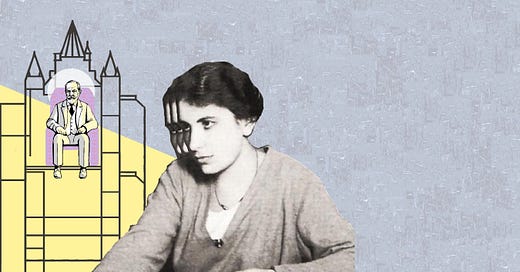A Deep Reading of Why Freud Was Wrong: Sin, Science and Psychoanalysis, by Richard Webster
(Part One · Part Two · Part Three · Part Four · Part Five · Part Six · Part Seven · Part Eight · Part Nine)
(Art by Michelle Horsley)
More Cast-Offs & the Collapse of the Secret Committee
Picking up where we left off on Monday: besides Jung, Otto Rank was another young apostate who was pathologized and demonized by Freud and his minions. In this case, the accused submitted and became abjectly apologetic, and so was allowed to remain.
Rank’s rebellion had to do with emphasizing the mother in the psychological formation of the child, and how this underscored a major weakness in Freud’s system. (Freud focused on the father to the almost complete exclusion of the mother and of women’s sexuality, a weakness that will become painfully apparent in the case of his daughter, Anna).
Then there was Sándor Ferenczi, a loyal disciple until the point he began to question Freud’s reneging on his seduction theory, and became more and more interested in the actuality of child sexual abuse: “in every case which he discussed in his clinical diary, for instance, Ferenczi traced the patient’s neurosis back to traumas occasioned by sexual abuse suffered during childhood” (p. 396).
An even more cardinal sin that Ferenczi committed was to doubt the efficacy of Freud’s psychoanalytical method, which involved remaining aloof, unreachable, and totally inexpressive with the patient. Ferenczi thought that being more involved, friendly, and warm, showing compassion, even sharing personal stories with the patient, was a more effective approach.
Freud was indignant, and Ferenczi quickly came to be regarded as another heretic. He was diagnosed by the group as suffering from a mental breakdown, as being essentially insane, and he died soon after (perhaps unrelated, he died from pernicious anemia; but then again, perhaps not).
Webster quotes German psychiatrist Thomas Szasz (not a contemporary of Freud’s) on Freud’s leadership:
Overt tyranny can be appraised for what it is, and there are many ways of resisting it. Freud’s leadership, however, was deceitful. He created a pseudo-democratic, pseudo-scientific atmosphere, but was careful to retain for himself the power to decide all important issues. . . . Freud’s essential concept of leadership seemed to be to bestow tokens of power on his competitors, only to discredit them if they dared to use it (p. 399).
A few years before Ferenczi died, the Secret Committee was effectively disbanded, being deemed no longer necessary now that the movement had grown internationally. It was replaced with an open committee. As Webster writes,
The great danger attendant on the collapse of the Secret Committee was that Freud’s own personal definition of truth would be overthrown and replaced by other equally subjective visions shaped by cultural and intellectual fashion or by the charismatic qualities of their originators. This is exactly what happened to the psychoanalytic movement in the second half of the twentieth century (p. 400).
Anna Disaster
In the last chapter of part two of Why Freud Was Wrong, Webster focuses on perhaps the greatest casualty of Freudianity—as well as its leading evangelist—Freud’s daughter, Anna.
Webster mentions that Anna appeared to have anorexia as a teenager, at least based on the letters Freud wrote her, with references to plumping her up that emphasize the importance of her putting on weight. Though neither Webster nor Freud (in Webster’s book) mention this, anorexia can be symptomatic of sexual abuse.
Anna was born in 1895 when Freud was 29 (time of Saturn return). She became interested in psychoanalysis in 1918, at age 23, and in order to pursue a career in it, she needed to submit to analysis. Freud nominated himself as her analyst.
At the time, such a bizarre decision went completely unquestioned (at least, there’s no reference to its being questioned), and Anna went meekly along with it. Nor did Freud ever acknowledge the unorthodoxy—and inappropriateness—of his decision. It of course went unquestioned by Freud’s followers at the time; much more bizarrely, according to Webster, it continued to be largely unquestioned even after his death.
As unbelievable as this sounds, it can only indicate the sort of followers Freudianity has attracted, and their slavish devotion to the idea of the master’s impeccability.





